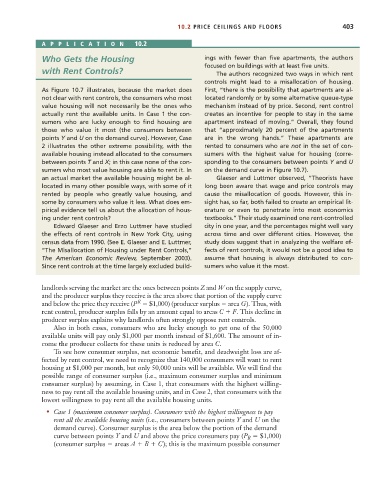Page 429 - Microeconomics, Fourth Edition
P. 429
c10competitive markets applications.qxd 7/15/10 4:58 PM Page 403
10.2 PRICE CEILINGS AND FLOORS 403
APPLICA TION 10.2
Who Gets the Housing ings with fewer than five apartments, the authors
focused on buildings with at least five units.
with Rent Controls? The authors recognized two ways in which rent
controls might lead to a misallocation of housing.
As Figure 10.7 illustrates, because the market does First, “there is the possibility that apartments are al-
not clear with rent controls, the consumers who most located randomly or by some alternative queue-type
value housing will not necessarily be the ones who mechanism instead of by price. Second, rent control
actually rent the available units. In Case 1 the con- creates an incentive for people to stay in the same
sumers who are lucky enough to find housing are apartment instead of moving.” Overall, they found
those who value it most (the consumers between that “approximately 20 percent of the apartments
points Y and U on the demand curve). However, Case are in the wrong hands.” These apartments are
2 illustrates the other extreme possibility, with the rented to consumers who are not in the set of con-
available housing instead allocated to the consumers sumers with the highest value for housing (corre-
between points T and X; in this case none of the con- sponding to the consumers between points Y and U
sumers who most value housing are able to rent it. In on the demand curve in Figure 10.7).
an actual market the available housing might be al- Glaeser and Luttmer observed, “Theorists have
located in many other possible ways, with some of it long been aware that wage and price controls may
rented by people who greatly value housing, and cause the misallocation of goods. However, this in-
some by consumers who value it less. What does em- sight has, so far, both failed to create an empirical lit-
pirical evidence tell us about the allocation of hous- erature or even to penetrate into most economics
ing under rent controls? textbooks.” Their study examined one rent-controlled
Edward Glaeser and Erzo Luttmer have studied city in one year, and the percentages might well vary
the effects of rent controls in New York City, using across time and over different cities. However, the
census data from 1990. (See E. Glaeser and E. Luttmer, study does suggest that in analyzing the welfare ef-
“The Misallocation of Housing under Rent Controls,” fects of rent controls, it would not be a good idea to
The American Economic Review, September 2003). assume that housing is always distributed to con-
Since rent controls at the time largely excluded build- sumers who value it the most.
landlords serving the market are the ones between points Z and W on the supply curve,
and the producer surplus they receive is the area above that portion of the supply curve
R
and below the price they receive (P $1,000) (producer surplus area G). Thus, with
rent control, producer surplus falls by an amount equal to areas C F. This decline in
producer surplus explains why landlords often strongly oppose rent controls.
Also in both cases, consumers who are lucky enough to get one of the 50,000
available units will pay only $1,000 per month instead of $1,600. The amount of in-
come the producer collects for these units is reduced by area C.
To see how consumer surplus, net economic benefit, and deadweight loss are af-
fected by rent control, we need to recognize that 140,000 consumers will want to rent
housing at $1,000 per month, but only 50,000 units will be available. We will find the
possible range of consumer surplus (i.e., maximum consumer surplus and minimum
consumer surplus) by assuming, in Case 1, that consumers with the highest willing-
ness to pay rent all the available housing units, and in Case 2, that consumers with the
lowest willingness to pay rent all the available housing units.
• Case 1 (maximum consumer surplus). Consumers with the highest willingness to pay
rent all the available housing units (i.e., consumers between points Y and U on the
demand curve). Consumer surplus is the area below the portion of the demand
curve between points Y and U and above the price consumers pay (P $1,000)
R
(consumer surplus areas A B C); this is the maximum possible consumer

